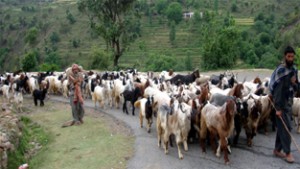Excelsior Correspondent

JAMMU, Apr 12: The Gujjars and Bakerwals nomadic tribes have begun their bi-annual seasonal migration towards upper reaches of Shivalik, Pirpanjal and Trikuta Hills of north western Himalayas on schedule dates due to rise in the day temperature in plane areas of Jammu.
“The tradition of seasonal Tribal migration is surviving since centuries and nomadic tribes mainly Gujjar and Bakerwal people migrate to their summer destinations in the first week of April every year and reach to their fixed areas after 40 to 45 days of travel”, said Dr Javaid Rahi, Secretary, Tribal Research and Cultural Foundation-an organization working on different aspect of Gujjars.
A handout by the Foundation has impressed upon various institutions working for Tribal development in the State to mobilize resources for providing necessary logistics to migratory tribes like establishment of Mobile Animal Dispensaries, Health Facilities on migration routes etc.
Dr Javaid Rahi said that the main migration routes, including Jamiya Gali, Gora Batta, Nanansar, Ropadi Dharhal Pass, Mughal Road and others, were badly damaged due to heavy snowfall and rain during last winter and required immediate repairs.
While interacting with migratory nomads, Secretary TRCF informed that the matter regarding restoration of all restricted pasture and Dhoks located near Indo-Pak border and in Ladakh areas of the State to Gujjar and Bakerwals was taken with the Defence Ministry.
“Due to restriction in Tribal movement in several areas, the Gujjars-Bakerwals are facing extreme adversities, toughest lifestyle, and lack of economic freedom owing to deficiency of resources so they (Tribal) deserve special attention of State and Central Governments,” the Foundation communique reads.
The Gujjars constituted more than 20 per cent population of the State and around 6 lakh people who are nomadic move after every six months with their livestock and undertake seasonal migration.

